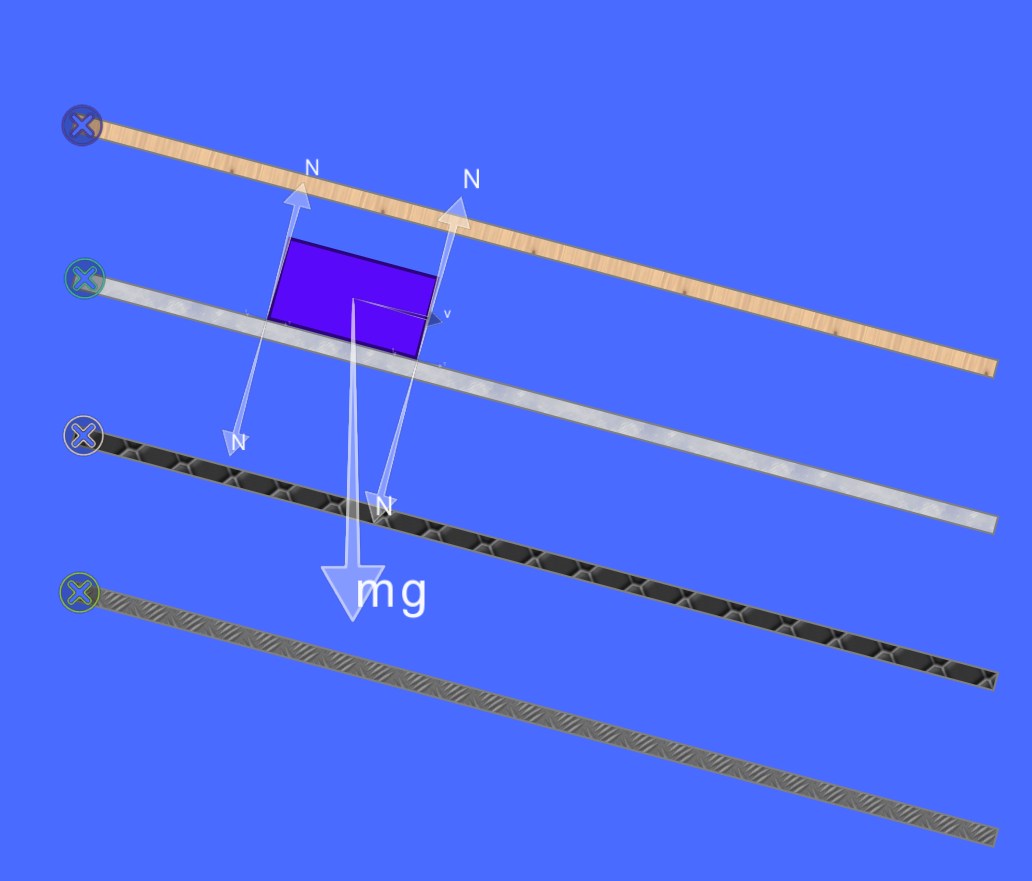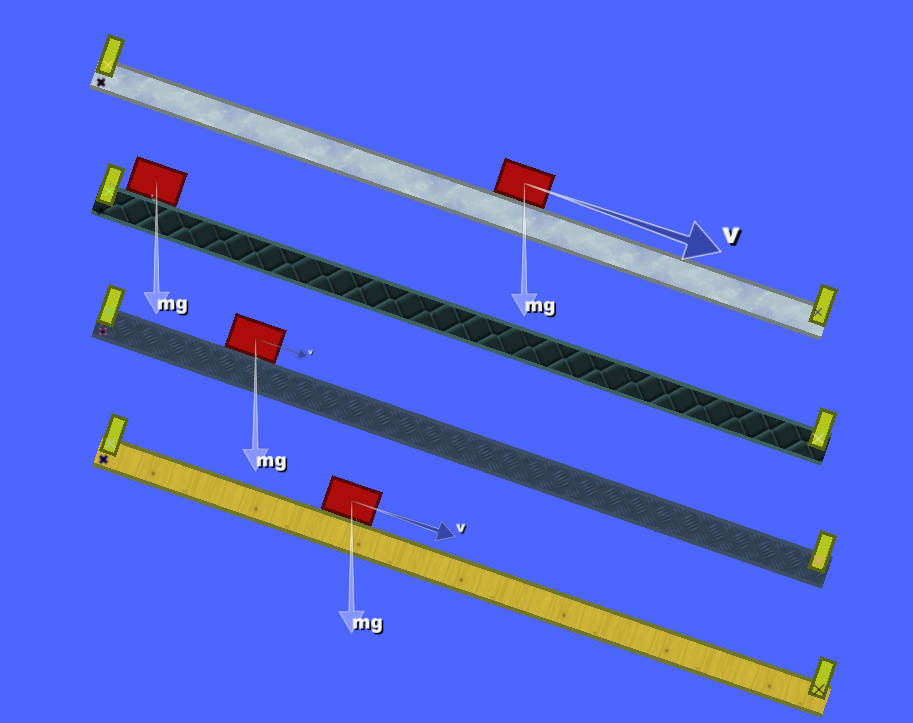Jj Chinese
From Algodoo
(Difference between revisions)
m (Copied from Friction of a sliding object) |
m (Copied from 滑る物体に働く摩擦) |
||
| (One intermediate revision not shown) | |||
| Line 1: | Line 1: | ||
{{Lesson | {{Lesson | ||
| - | |language=lesson- | + | |language=lesson-japanese |
| - | |title= | + | |title=滑る物体に働く摩擦 |
| - | |description= | + | |description=摩擦は動きを理解する上で重要な概念です。 |
| + | このレッスンでは様々な物質間に働く摩擦について調べます。<br /> | ||
| + | 平坦な床に置かれた物体は、どう振舞うでしょう。 | ||
| + | 床が斜面になっている場合、物体はどうなるか。 | ||
| + | この動きは床表面の物性にどう影響されるか。 | ||
|target=lesson-keystage3 | |target=lesson-keystage3 | ||
|type=lesson-demonstration, lesson-exercise | |type=lesson-demonstration, lesson-exercise | ||
|keywords=lesson-friction, lesson-motion | |keywords=lesson-friction, lesson-motion | ||
| - | |objectives= | + | |objectives=*摩擦が低い状態と高い状態を見分ける。 |
| - | + | *力としての摩擦を理解する。 | |
| - | + | *質量が摩擦の大きさに影響することを知る。 | |
| - | + | *接触している面積が摩擦の大きさに影響することを知る。 | |
| - | |inclass= | + | |inclass=次のことについて議論します。 |
| - | + | *異なった表面の性質について。 | |
| - | + | *高い摩擦、低い摩擦はそれぞれ何を意味するか。 | |
| - | + | *実世界で、高い摩擦はどのような時に役立つか(例:クルマや自転車のタイヤ、クツ、軍手)。 | |
| - | + | *実世界で、低い摩擦はどのような時に役立つか(例:スケート、スキー、公園のすべり台)。 | |
| - | ( | + | *摩擦の高い斜面ではどのようなことが起きるか。 |
| - | + | *摩擦の低い斜面ではどのようなことが起きるか。 | |
| - | + | *議論した内容をアルゴドゥで再現して調べるにはどうしたら良いか。 | |
| - | + | 児童にシーンを作成させます。このとき、みんなで出したアイデアや独自のアイデアを試させるようにします。児童に方針を立てるのを助け、ガイドとなる問いかけをしてください。 | |
| - | + | <br /> | |
| - | + | <br /> | |
| - | + | 次の順序で学習を進めさせます。<br /> | |
| - | + | '''シーンの作成 - 予測 - シミュレーションの実行 - 検証'''<br /> | |
| - | + | <br /> | |
| + | シミュレーション後に実験結果を共有させます。 | ||
}} | }} | ||
{{StartScenes}} | {{StartScenes}} | ||
| Line 30: | Line 35: | ||
{{StartInAlgodoo}} | {{StartInAlgodoo}} | ||
{{Section | {{Section | ||
| - | |headline= | + | |headline=シーンの作成 |
| - | |text= | + | |text=ボックスツールを用いて様々な斜面を作成し、それぞれ別の摩擦を割り当てます。<br /> |
| + | 力と速度のベクトルを表示する設定にし、小さなボックスに斜面上を滑らせて摩擦を調べます。 | ||
}} | }} | ||
{{Section | {{Section | ||
| - | |headline= | + | |headline=予測 |
| - | |text= | + | |text=次のことを予想します。 |
| + | *別々の斜面で、ボックスがどのように加速していくか。 | ||
| + | *斜面による違いはあるか。 | ||
| + | なぜそのように予想しましたか? | ||
|image=frictionnew.png | |image=frictionnew.png | ||
}} | }} | ||
{{Section | {{Section | ||
| - | |headline= | + | |headline=シミュレーションの実行 |
| - | |text= | + | |text=シミュレーションをスタートさせ、ボックスが坂を滑り降りる様子を観察します。 |
}} | }} | ||
{{Section | {{Section | ||
| - | |headline= | + | |headline=検証 |
| - | |text= | + | |text=次のことを検証します。 |
| + | *地面の勾配が大きくなるとどうなるか | ||
| + | *地面の勾配が小さくなるとどうなるか | ||
| + | *どの地面でも同様の結果が得られるか。 | ||
}} | }} | ||
{{Section | {{Section | ||
| - | |headline= | + | |headline=シーンを発展させる |
| - | |text= | + | |text=ボックスツールを用いて様々な斜面を作成し、それぞれ別の摩擦を割り当てます。斜面は互いに平行にしておきます。 |
| + | それぞれの斜面の下端にストッパーを取り付けて、斜面に置いた物体が落ちないようにします。 | ||
| + | 小さなボックスを作成し、同一のボックスをそれぞれの斜面に配置します。これにより、異なった摩擦の斜面におけるシミュレーションを観察することができます。 | ||
| + | <br /> | ||
| - | + | 異なったサイズのボックスでも実験を行い、接触面積による違いを観察します。 | |
| + | このとき使用するボックスは先程のボックスと同じ質量にしておきます。 | ||
| + | <br /> | ||
| - | + | 上手く観察できたら、さらに、ボックスに先程と異なる質量を割り当てて実験を行います。 | |
| - | |||
|image=friction-2.png | |image=friction-2.png | ||
}} | }} | ||
{{EndInAlgodoo}} | {{EndInAlgodoo}} | ||
Latest revision as of 06:35, 6 November 2012
滑る物体に働く摩擦
| Language: | 日本語 |
|---|---|
| Description: | 摩擦は動きを理解する上で重要な概念です。
このレッスンでは様々な物質間に働く摩擦について調べます。 |
| Target: | Key Stage 3 |
| Category: | Demonstration, Exercise |
| Discipline: | Friction, Motion |
| Learning objectives: |
|
| In class: | 次のことについて議論します。
児童にシーンを作成させます。このとき、みんなで出したアイデアや独自のアイデアを試させるようにします。児童に方針を立てるのを助け、ガイドとなる問いかけをしてください。
|
Steps in Algodoo
シーンの作成
ボックスツールを用いて様々な斜面を作成し、それぞれ別の摩擦を割り当てます。
力と速度のベクトルを表示する設定にし、小さなボックスに斜面上を滑らせて摩擦を調べます。
力と速度のベクトルを表示する設定にし、小さなボックスに斜面上を滑らせて摩擦を調べます。
予測
次のことを予想します。
- 別々の斜面で、ボックスがどのように加速していくか。
- 斜面による違いはあるか。
シミュレーションの実行
シミュレーションをスタートさせ、ボックスが坂を滑り降りる様子を観察します。
検証
次のことを検証します。
- 地面の勾配が大きくなるとどうなるか
- 地面の勾配が小さくなるとどうなるか
- どの地面でも同様の結果が得られるか。
シーンを発展させる
ボックスツールを用いて様々な斜面を作成し、それぞれ別の摩擦を割り当てます。斜面は互いに平行にしておきます。
それぞれの斜面の下端にストッパーを取り付けて、斜面に置いた物体が落ちないようにします。
小さなボックスを作成し、同一のボックスをそれぞれの斜面に配置します。これにより、異なった摩擦の斜面におけるシミュレーションを観察することができます。
異なったサイズのボックスでも実験を行い、接触面積による違いを観察します。
このとき使用するボックスは先程のボックスと同じ質量にしておきます。





